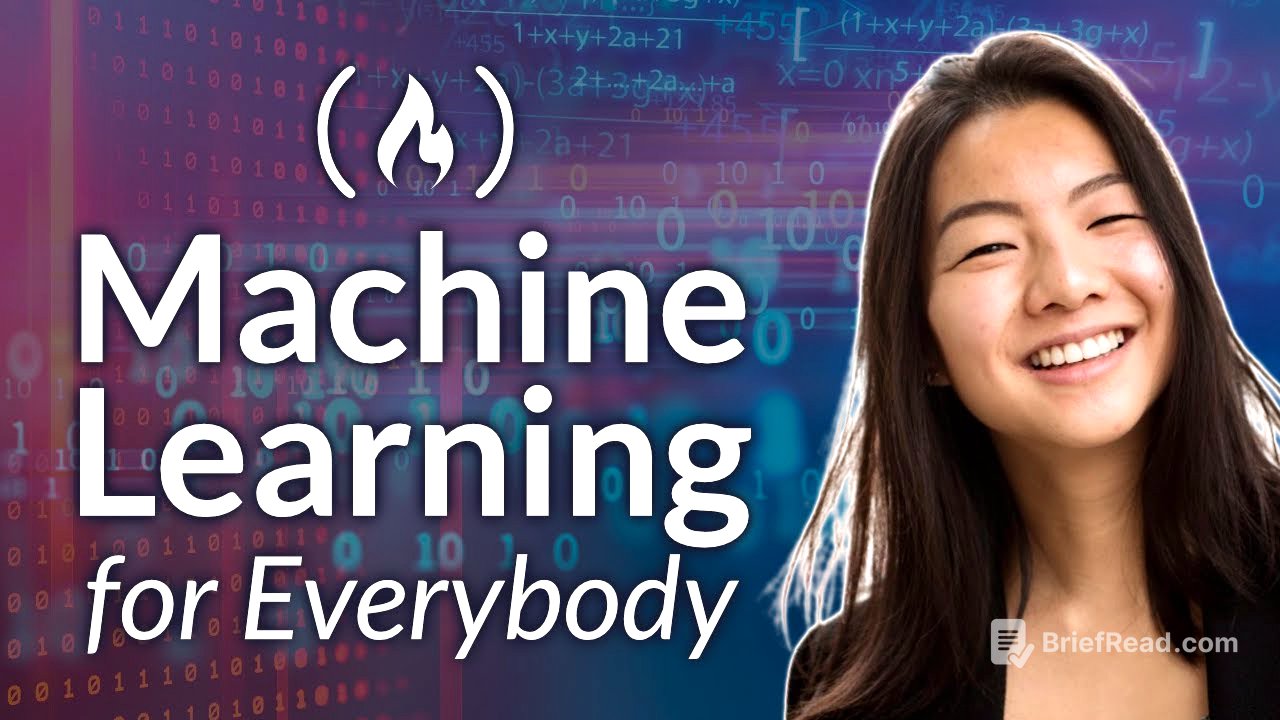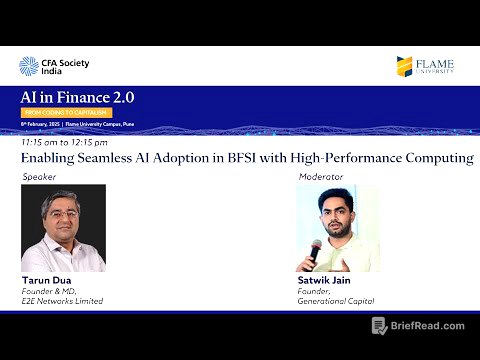TLDR;
Kylie Ying's "Machine Learning for Everyone" video provides a beginner-friendly introduction to machine learning, covering supervised and unsupervised learning models with practical coding examples in Google Colab. The video explains key concepts, algorithms, and evaluation techniques, making machine learning accessible to individuals without prior experience.
- Supervised and unsupervised learning models are explained with code examples.
- Key machine learning concepts like classification, regression, and model evaluation are discussed.
- Practical implementation using Google Colab and scikit-learn is demonstrated.
Introduction [0:00]
Kylie Ying introduces the "Machine Learning for Everyone" video, designed for anyone interested in machine learning. The video will cover supervised and unsupervised learning models, their underlying logic and math, and practical implementation using Google Colab. Viewers are encouraged to provide corrections and insights in the comments to foster a collaborative learning environment.
Magic Gamma Telescope Data Set [0:58]
Kylie starts with the UCI machine learning repository and uses the "magic gamma telescope data set" as an example. This data set involves using properties of light patterns recorded by a gamma telescope to predict whether a particle is a gamma particle or a hadron. The data set is downloaded, and the video demonstrates how to import necessary libraries like NumPy, pandas, and matplotlib in Google CoLab.
Importing and Preparing the Data [3:35]
The video shows how to import the downloaded data file into Google CoLab and use pandas to read the CSV file. Since the data doesn't initially have column labels, Kylie creates a list of attribute names from the data set description and assigns them as column names in the pandas DataFrame. The class labels, which are initially 'G' and 'H' (for gammas and hadrons), are converted to numerical values (0 and 1) for better computer understanding.
Supervised Learning and Terminology [6:52]
Kylie explains that the goal is to predict whether future samples are gamma or hadron particles, which is a classification problem. The attributes used for prediction are called "features," and the class column is the "label." This example demonstrates supervised learning, where the model learns from labeled data to predict future outcomes. Machine learning is defined as a sub-domain of computer science focused on algorithms that allow computers to learn from data without explicit programming. AI, ML, and data science are overlapping fields, with machine learning being a subset of AI and data science using machine learning to find patterns and insights.
Types of Machine Learning [9:45]
The video outlines three main types of machine learning: supervised learning, unsupervised learning, and reinforcement learning. Supervised learning uses labeled inputs to train models and predict outputs for new inputs. Unsupervised learning uses unlabeled data to find patterns and structures. Reinforcement learning involves an agent learning in an interactive environment based on rewards and penalties. The course focuses on supervised and unsupervised learning models.
Supervised Learning: Features and Predictions [12:21]
In supervised learning, a model takes a feature vector as input and produces a prediction as output. Features can be qualitative (categorical) or quantitative (numerical). Qualitative features include nominal data (e.g., gender, nationality) and ordinal data (e.g., age groups, ratings). Nominal data is often one-hot encoded for computer processing. Quantitative features are numerical and can be discrete (integers) or continuous (real numbers).
Supervised Learning: Classification and Regression [17:21]
Supervised learning tasks include classification and regression. Classification involves predicting discrete classes, such as hot dog vs. not hot dog (binary classification) or cat, dog, lizard (multi-class classification). Regression involves predicting continuous values, such as the price of Ethereum, temperature, or house prices.
Model Evaluation: Training, Validation, and Testing [19:43]
The video explains how to evaluate machine learning models using training, validation, and testing datasets. The training data is used to train the model, the validation data is used as a reality check during and after training, and the testing data is used as a final check to assess how well the model generalizes to unseen data. The difference between the model's prediction and the true value is known as "loss."
Loss Functions and Performance Measures [27:29]
Loss functions quantify the difference between predictions and actual labels. Examples include L1 loss (absolute value), L2 loss (squared difference), and binary cross-entropy loss (for binary classification). Accuracy is another measure of performance, calculated as the percentage of correct predictions.
Data Preparation in Colab [30:17]
Back in the Colab notebook, the class labels are verified to be numerical (0 and 1). Histograms are plotted for each feature to visualize their relationship with the class label. The data is split into training, validation, and test sets. The features are scaled using the StandardScaler to ensure they are on a similar scale, which can improve model performance.
Oversampling and Data Scaling [40:13]
The training data is oversampled using the RandomOverSampler to balance the number of gamma and hadron particles. Oversampling is only applied to the training data to avoid biasing the validation and test sets. The scale data set function is defined to scale the data and apply oversampling if needed.
K-Nearest Neighbors (KNN) [44:39]
Kylie introduces the K-Nearest Neighbors (KNN) algorithm, explaining how it classifies new data points based on the majority class among their nearest neighbors. The concept of Euclidean distance is explained as a way to measure the distance between data points. The choice of K (number of neighbors) is discussed, and the scikit-learn library is used to implement KNN.
KNN Implementation and Evaluation [52:39]
The video demonstrates how to implement KNN using scikit-learn, fit the model to the training data, and make predictions on the test set. The classification report is used to evaluate the model's performance, including precision, recall, F1-score, and accuracy. The impact of different K values on the model's performance is explored.
Naive Bayes and Conditional Probability [58:35]
The video introduces the Naive Bayes algorithm, starting with an explanation of conditional probability and Bayes' rule. A hypothetical COVID testing scenario is used to illustrate how to calculate the probability of having COVID given a positive test result. Bayes' rule is presented as a way to calculate conditional probabilities when direct data is not available.
Bayes' Rule in Action and Naive Bayes [1:02:43]
Bayes' rule is applied to a disease statistics example to calculate the probability of having a disease given a positive test result. The concept is expanded to classification, leading to the Naive Bayes algorithm. Key terminology such as posterior, likelihood, prior, and evidence are defined. The "naive" aspect of the algorithm comes from the assumption that all features are independent.
Naive Bayes Implementation and Evaluation [1:17:31]
The Gaussian Naive Bayes algorithm is implemented using scikit-learn. The model is fit to the training data, and predictions are made on the test set. The classification report is used to evaluate the model's performance. The results are compared to those of the KNN model.
Logistic Regression and the Sigmoid Function [1:19:16]
Logistic regression is introduced as a method for classification. The video explains how linear regression is adapted for classification by using the sigmoid function to constrain the output between 0 and 1, representing probabilities. The mathematical derivation of the sigmoid function is shown.
Logistic Regression Implementation and Evaluation [1:27:19]
Logistic regression is implemented using scikit-learn. The model is fit to the training data, and predictions are made on the test set. The classification report is used to evaluate the model's performance. Different penalty parameters are mentioned as options for tuning the model.
Support Vector Machines (SVM) [1:29:13]
Support Vector Machines (SVMs) are introduced as a classification technique. The goal of SVM is to find the hyperplane that best differentiates between two classes while maximizing the margin. The concept of support vectors is explained. The kernel trick is mentioned as a way to handle non-linearly separable data.
SVM Implementation and Evaluation [1:37:33]
The Support Vector Classifier (SVC) is implemented using scikit-learn. The model is fit to the training data, and predictions are made on the test set. The classification report is used to evaluate the model's performance, which shows a significant improvement in accuracy compared to previous models.
Neural Networks: Structure and Activation Functions [1:39:37]
Neural networks are introduced as a powerful type of model. The basic structure of a neural network is explained, including input layers, hidden layers, and output layers. The role of neurons and activation functions is discussed. Activation functions, such as sigmoid, tanh, and ReLU, introduce non-linearities that allow the model to learn complex patterns.
Neural Networks: Training and Backpropagation [1:43:32]
The training process of a neural network is explained, including the concepts of loss, gradients, and backpropagation. Gradient descent is used to adjust the weights in the model to minimize the loss. The learning rate controls how quickly the model adjusts its weights.
Neural Networks: Implementation with TensorFlow [1:48:36]
TensorFlow is introduced as a library for developing and training machine learning models. The video demonstrates how to define a sequential neural network using TensorFlow, including dense layers and activation functions. The model is compiled with an optimizer, loss function, and metrics.
Neural Networks: Training and Evaluation [1:52:55]
The neural network is trained using the fit method, and the training history is recorded. The loss and accuracy are plotted over the training epochs to visualize the learning process. The validation split is used to monitor the model's performance on a portion of the training data.
Neural Networks: Hyperparameter Tuning and Grid Search [1:56:54]
The video discusses hyperparameter tuning and introduces the concept of a grid search to find the best combination of hyperparameters. A function is defined to train the model with different numbers of nodes, dropout probabilities, learning rates, and batch sizes. The validation loss is used to select the best model.
Neural Networks: Final Evaluation and Comparison [2:05:51]
After training, the best model is used to make predictions on the test set. The classification report is used to evaluate the model's performance. The results are compared to those of the SVM model, showing that the neural network achieves similar accuracy.
Linear Regression: Concepts and Assumptions [2:10:11]
The video transitions to regression, starting with an explanation of linear regression. The goal of linear regression is to find the line of best fit that models the relationship between the input (x) and the output (y). The equation for linear regression is presented, and the concepts of residuals and error minimization are discussed. The assumptions of linear regression, including linearity, independence, normality, and homoscedasticity, are explained.
Linear Regression: Evaluation Metrics [2:22:37]
Various evaluation metrics for linear regression are introduced, including mean absolute error (MAE), mean squared error (MSE), root mean squared error (RMSE), and the coefficient of determination (R-squared). The pros and cons of each metric are discussed.
Linear Regression: Implementation and Example [2:34:26]
The video demonstrates linear regression using a bike sharing dataset. The data is imported, preprocessed, and split into training, validation, and test sets. Simple linear regression is performed using only the temperature feature, and the results are visualized. Multiple linear regression is also performed using all available features.
Neural Networks for Regression [2:54:49]
The video explores using neural networks for regression. A simple neural network with one dense layer is created and trained on the bike sharing data. The results are compared to those of the linear regression model. A more complex neural network with multiple layers is also explored.
Unsupervised Learning: K-Means Clustering [3:12:25]
The video transitions to unsupervised learning, starting with an explanation of K-Means clustering. The goal of K-Means clustering is to group data points into K clusters based on their proximity to cluster centroids. The steps of the K-Means algorithm are explained, including initialization, assignment, and centroid recalculation. The concept of expectation maximization is introduced.
Unsupervised Learning: Principal Component Analysis (PCA) [3:23:46]
Principal Component Analysis (PCA) is introduced as a dimensionality reduction technique. The goal of PCA is to find the principal components, which are the directions in the data with the largest variance. PCA can be used to reduce the number of features while preserving as much information as possible.
Unsupervised Learning: Implementation and Example [3:33:50]
The video demonstrates unsupervised learning using a seeds dataset. The data is imported, preprocessed, and K-Means clustering is performed. The results are visualized and compared to the true class labels. PCA is also performed to reduce the dimensionality of the data, and the results are visualized.
Conclusion [3:53:32]
Kylie concludes the video, summarizing the key concepts and techniques covered. Viewers are encouraged to provide feedback and insights in the comments.









